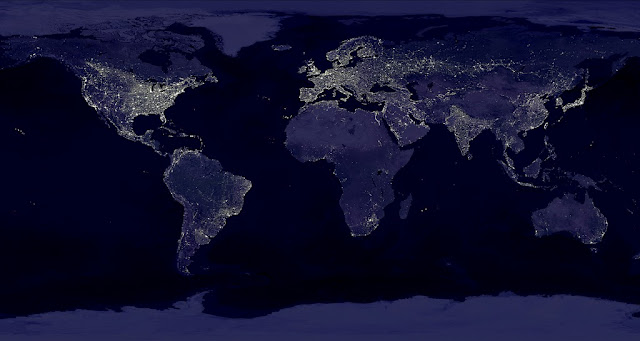A recently released report,
NATO 2020, outlines expert recommendations for the alliance’s new strategic concept. However, while pointing to a nighttime satellite image of the globe at
a Wilson Center conference last week,
Professor Peter Liotta of Salve Regina University said the report focuses too much on conventional self-defense, when most of the new security challenges of the 21st century will come from areas of the world “where the lights are out.”
In an interview with New Security Beat, Liotta criticized NATO 2020’s emphasis on what he sees as a reactive, rather than a proactive, stance. By ignoring “new security” vulnerabilities such as environmental and demographic challenges, NATO may end up creating more threats for itself down the line, he said.
The report briefly acknowledges that demographic change and environmental degradation represent sources of uncertainty in forecasting global trends. However, neither are included as major threats to the alliance. Instead, the authors say the most probable threats are nuclear or non-nuclear armed ballistic missiles, terror attacks, and cyber intrusion.
Discussions about non-traditional security vulnerabilities often produce contentious and conflicting viewpoints, which makes it easier to ignore them, said Liotta. However, it is important for NATO to realize that security threats – even more conventional ones – do not exist in isolation.
Liotta said the continued focus on NATO’s Article 5, the invocation of collective self-defense, overshadows other important foundations of the alliance. For example, Article 2, which encourages “promoting conditions of stability,” could be invoked to help the alliance address non-traditional security threats.
In his presentation, Liotta, formerly of the U.S. Naval War College, cited mass migration, water scarcity, and low probability, high-risk events, such as rapid sea-level rise from Arctic ice melt, as examples of challenges that NATO should be preparing to meet. He also drew attention to the security challenges of a burgeoning global population, saying that rapid growth and urbanization will produce 600 cities with more than one million people by 2025.
Such extreme events as the 2008 earthquake in Sichuan, China, which killed about 90,000 people and left five million homeless, might be a symptom of the strain our growing population has placed on the Earth’s natural systems, said Liotta. Scientists point out that an earthquake of such magnitude has never been seen in Sichuan and that large construction projects – particularly a large dam and reservoir that lie within 550 yards of the fault line – have likely had a considerable effect on local geology.
In Europe’s current deployment-adverse, difficult fiscal environment, it is perhaps understandable that NATO planners would focus on concrete threats rather than emerging vulnerabilities. But, as Liotta argues, the consequences for ignoring these new security challenges could be no less dire.
Sources: Daily Mail, Foreign Policy, NATO, Telegraph.
Photo Credit: “The Night Lights of Planet Earth” courtesy of flickr user woodleywonderworks.
 A Publication of the Stimson Center.
A Publication of the Stimson Center.




